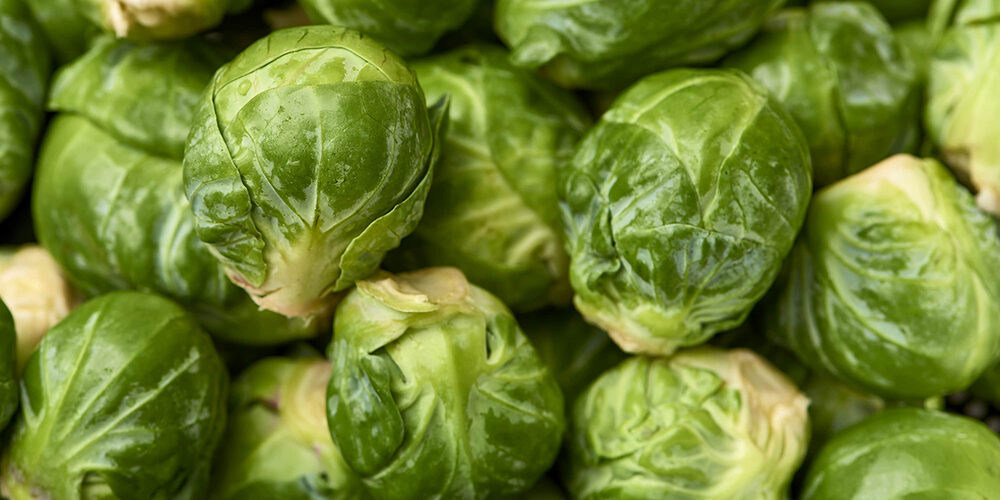Growing Brussels Sprouts

Brussels sprouts are a member of the cabbage family, and an excellent source of protein and vitamins. Here’s how to plant, grow, and harvest Brussels sprouts in your garden!
They require a long growing season (80+ days to harvest), and are generally more successful when grown for a fall or early winter harvest, as they only increase in flavor after a light frost or two.
Brussels sprouts are a cultivar (cultivated variety) of Brassica oleracea, which is the same plant species that cabbage, broccoli, cauliflower, kale, kohlrabi, and a number of other popular foods stem from. Over generations and generations, this versatile plant has been bred in different ways to highlight its different features: flowers, leaves, and root.
Planting
Due to Brussels sprouts’ need for a long growing season, plant them with a fall or winter harvest in mind.
When to plant Brussels sprouts
- To determine planting time, count backwards from your first fall frost date. Direct sow seeds into the garden about 4 months before the first fall frost. (See local frost dates.)
- In regions with cold winters, where temperatures are regularly below freezing, start seeds indoors about 2 to 3 weeks before the last spring frost date for an early fall harvest.
- In regions with mild winters, where temperatures are occasionally below freezing, start seeds outdoors in early to mid-summer for a mid-fall or early winter harvest.
- In regions with warm winters, where temperatures are rarely or never below freezing, start seeds outdoors in late summer for a mid- to late winter harvest.
How to plant Brussels sprouts
- Raised beds are especially recommended for cold-season vegetables, especially when seasons are changing and temps are not consistent.
- Work several inches of aged manure and/or compost into soil a few days before planting or transplanting.
- If direct sowing seeds, plant ½ inch deep and 2 to 3 inches apart.
- Plant transplanted seedlings 12 to 24 inches apart.
- Water well at time of planting/transplanting and with 1 to 1 ½ inches per week thereafter.
Care
- Thin plants to 12 to 24 inches apart when they reach 6 inches tall.
- Fertilize with a nitrogen-rich product after thinning. Repeat every 3 to 4 weeks.
- Mulch to retain moisture and keep the soil temperature cool.
- If growing during hot weather, be sure to keep the plants well watered.
- Do not disturb the soil around the plants; roots are shallow and susceptible to damage.
- Remove yellowing leaves to allow for more sunlight on the stalk and focus plant energy on healthy growth.
- To encourage plants to head up faster, cut off the top leaves 3 to 4 weeks before harvest.
- To harvest leaves during winter, leave top leaves intact; they provide protection from snow.
- Cover plants with 10 to 12 inches of mulch if you plan to harvest into the winter.
Pests/Diseases
- Aphids
- Cabbage Root Maggots
- Flea Beetles
- Clubroot
- Downy Mildew
- White Mold
Harvest/Storage
How to harvest Brussels sprouts
- Sprouts mature from the bottom of the stalk upwards. Harvest sprouts from the bottom when they reach about 1 inch in diameter.
- If desired, after a moderate frost, pull up the entire stalk, roots and all. (Remove leaves first.) Then hang stalk upside down in a cool, dry basement or garage or barn.
- Store stalks (no roots) for about 1 month in a root cellar or basement.
How to store Brussels sprouts
- Do not wash the sprouts before storing them, only right before use.
- Keep fresh-picked sprouts in a plastic bag for up to 5 days in the refrigerator.
Recommended Varieties
- ‘Jade Cross’ is a high-yield compact plant, resistant to some diseases and known for its tolerance for hotter weather.
- ‘Oliver’ and ‘Long Island Improved’ are early-maturing varieties with shorter growing season requirements (80–90 days).
- ‘Churchill’ is an early maturing plant, adaptable to most climates.
- ‘Diablo’ is known as a heavy producer.
- ‘Falstaff’ has a red/purple hue that holds when cooked
- ‘Long Island Improved’ is an heirloom and a compact plant that prefers a cool summer.
Website: www.almanac.com